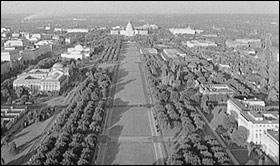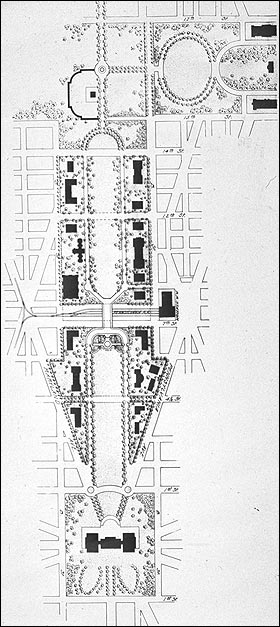|
 |
 Aerial view
of the Washington Mall. Aerial view
of the Washington Mall. |
| Credit: Library of Congress, Prints & Photographs Division, Theodor Horydczak Collection
|
 |
 |
L'Enfant's Suggestion for Mall, Washington, DC.
Credit: Courtesy of the Frances Loeb Library, Graduate School of Design, Harvard University
|
|
|

|
|
EARLY HISTORY:
The 19th century
In 1791, French Engineer Pierre L'Enfant was appointed by President
George Washington to create a plan for the development of the nation's
capital. At the center of the plan, L'Enfant conceived the National Mall,
a grand open promenade that would serve as the nation's monumental core.
However L'Enfant's vision (see drawing) of grand vistas with neo-classical
monuments would not be fulfilled until the 20th century. Although a monument
to George Washington was begun in 1846, the Civil War interrupted its
construction and it was not completed until 1885. For much of the 19th
century sheep grazed near the half completed Washington Monument. Also
disrupting the L'Enfant Plan for the Mall was a red brick medieval style
museum with the funds donated by Englishman, George Smithson and the insertion
of a railroad terminal cut into the Mall.
In 1901 a new plan for Washington D.C. was created by a commission headed
by Senator James McMillan and comprised of city planners Daniel Burnham,
Charles F. McKim, Frederick Law Olmsted Jr. and Augustus St. Gaudens,
all of whom had been involved in creating the great Chicago Columbian
Exposition of 1893. A City Beautiful movement that was influencing city
building throughout the nation inspired them. The McMillan plan created
monumental vistas and promoted Beaux-Arts architecture for the capital.
They succeeded in legitimizing a growing governmental structure by using
the landscaping of the Mall to re-enforce symbolic relationships (the
North-South and East-West axes of which the Capitol, the White House,
and the Washington Monument are the focus.) Their plans were completed
in 1922 with the dedication of the Lincoln Memorial.
Next: The Mall: 1901-1940 »
« Previous: Introduction
|